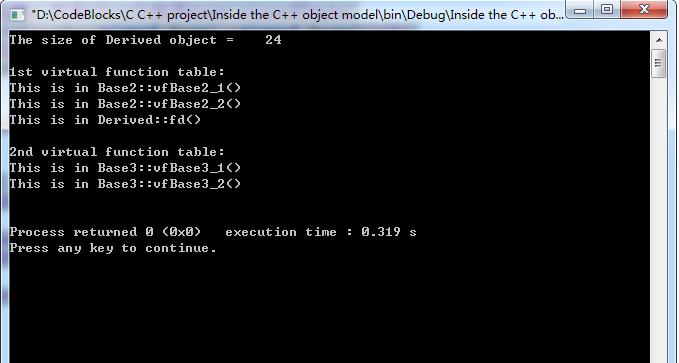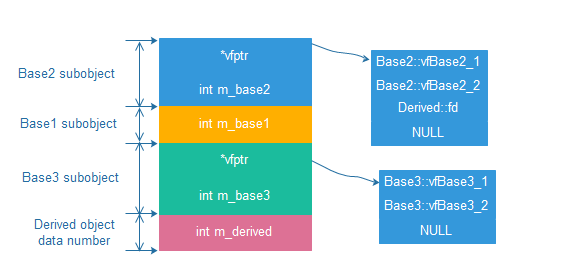如果在对象内存布局 (5)的代码中,将Base1中的两个虚函数声明删除,同时将main函数中的下面代码注释掉(因为现在只有两张虚函数表了):
代码如下:
#include <iostream> using namespace std; class Base1 { public: int m_base1; /*inline virtual void vfBase1_1() { cout << "This is in Base1::vfBase1_1()" << endl; } inline virtual void vfBase1_2() { cout << "This is in Base1::vfBase1_2()" << endl; }*/ }; class Base2 { public: int m_base2; inline virtual void vfBase2_1() { cout << "This is in Base2::vfBase2_1()" << endl; } inline virtual void vfBase2_2() { cout << "This is in Base2::vfBase2_2()" << endl; } }; class Base3 { public: int m_Base3; inline virtual void vfBase3_1() { cout << "This is in Base3::vfBase3_1()" << endl; } inline virtual void vfBase3_2() { cout << "This is in Base3::vfBase3_2()" << endl; } }; class Derived : public Base1, public Base2, public Base3 { public: int m_derived; inline virtual void fd() { cout << "This is in Derived::fd()" << endl; } }; typedef void (*VFun)(void); template<typename T> VFun virtualFunctionPointer(T* b, int i) { return (VFun)(*((int*)(*(int*)b) + i)); } int main(void) { Derived d; cout << "The size of Derived object = " << sizeof(Derived) << endl; cout << endl; cout << "1st virtual function table: " << endl; int i = 0; while(virtualFunctionPointer(&d, i)&&i<3) { VFun pVF = virtualFunctionPointer(&d, i++); pVF(); } cout << endl; cout << "2nd virtual function table: " << endl; i = 0; //以32字长的机器,找到下一个继承base class的vptr int* tmp = ((int*)&d)+(sizeof(Base1)+sizeof(Base2))/4; //虚函数表中的虚函数后面不为NULL?如果不加i的限制会出现段错误,不能结束循环 while(virtualFunctionPointer(tmp, i)&&i<2) { VFun pVF = virtualFunctionPointer(tmp, i++); pVF(); } cout << endl; /*cout << "3rd virtual function table: " << endl; i = 0; tmp = ((int*)&d) + sizeof(Base2)/4; while(virtualFunctionPointer(tmp, i)&&i<2) { VFun pVF = virtualFunctionPointer(tmp, i++); pVF(); }*/ return 0; }
运行结果:

通过修改代码的位置以及运行结果可以知道,Derived对象的memory layout图解如下:

由上面分析可知:
其一,Base1 subobject排列在Base2 subobject之后,而在Base3 subobject之前,尽管它在Derived类的继承列表中排列在首位,因为它已经没有虚函数表了,但仍然排列在Derived类的成员变量m_derived之前。
其二,在Derived类中定义的虚函数Derived::vfDerived()附加在一个虚函数表的最后,这时第一张虚函数表是类Base2的。